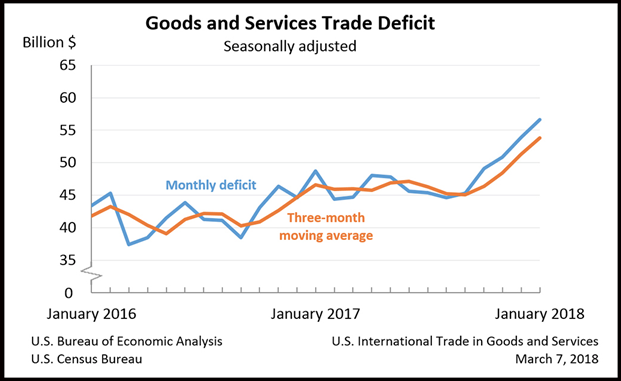By: Merrill Matthews – ipi.org – March 13, 2018
If President Donald Trump understood the balance of trade issue better, he’d be bragging about the rising trade deficit, because it’s correlated with a strong and growing economy. But he doesn’t, which creates the Trump Conundrum.
The U.S. usually has a trade deficit in goods but a trade surplus in services. For 2017, the trade deficit in goods was $810 billion, while the trade surplus in services was $244 billion, resulting in a goods and services deficit of $566 billion—the largest trade deficit since 2008.
Look at the accompanying graph from the U.S. Bureau of Economic Analysis. It depicts the U.S. international goods and services trade deficit.
As the graph shows, the goods and services trade deficit had been hovering around $40 billion to $45 billion per month, reflecting Obama’s slow-growth economy.
However, about the time of the presidential election the trade deficit ticked up to between $45 billion and $50 billion a month until mid-2017, and then began a significant rise—as Trump’s anti-regulatory efforts and other policies began having an impact.
The current trade deficit increase isn’t occurring because our trading partners are taking even more advantage of us, as the president likes to assert. It’s because rising wages, more business investment, and the “wealth effect” created by a booming stock market means U.S. consumers have more money in their pockets to spend—thanks to Trump’s economic policies.
And the GOP tax cut legislation means that Americans will have even more money in their pockets in the future, so there’s a good chance the trade deficit will rise even higher.
Alternatively, the trade deficit usually falls when the U.S. enters a recession, because people have less money to spend.
Trump’s policies are jumpstarting the economy, but that means the trade deficit will likely increase. Trump’s trade policies—imposing tariffs on competitors, especially those that play by the rules—may lower the trade deficit. But a lower trade deficit is correlated with a shrinking economy.
Trump can have a strong, growing economy, or he can reduce the trade deficit, but historically it is very unlikely he can do both. That’s the Trump conundrum.
To see this article, click read more.
Source: The Trump Conundrum
 Listen Online
Listen Online Watch Online
Watch Online Find a Station in Your Area
Find a Station in Your Area







 Listen Now
Listen Now Watch Online
Watch Online
